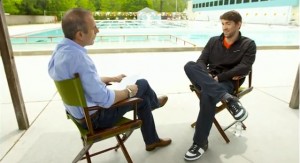 Right now the 2012 Olympics are captivating the world whether you’re a sports fan or not. Our deepest connection to the games often isn’t which country won or lost. What we are most drawn to are the gripping, inspiring stories of the athletes themselves and how they got to London. Backstories can be incredibly compelling stories to tell.
Right now the 2012 Olympics are captivating the world whether you’re a sports fan or not. Our deepest connection to the games often isn’t which country won or lost. What we are most drawn to are the gripping, inspiring stories of the athletes themselves and how they got to London. Backstories can be incredibly compelling stories to tell.
You can and should expose your own backstory too. In Part 1 of this series on creating great backstories, we covered why a backstory can grow your business. Now in this post, we dig into the how to develop an exceptional backstory.
What makes a backstory so interesting?
You may be thinking, “I’m not an Olympian. I’m promoting a business.” True, but the impact of telling your backstory applies to businesses, products or anything that you are promoting. It is a core part of your brand. Your audience cares and develops a more emotional connection with you.
A backstory typically includes the history of the people involved, their environment, critical moments and other not-so public information. That’s the good stuff. You are promoting interesting elements of your history that puts your brand or campaign in a favorable context. You are telling a story. You are enhancing your existing pitch.
I’ve had the good fortune of participating in major rebranding initiatives at two companies that I have worked for. Both were highly visible consumer brands with a lot at stake (can’t say, but you can probably guess). Both leveraged extensive customer research and testing to “get it right”.
However, one made it a point to dig into the company history to capture the essence of where they came from, who had the vision, what destiny-altering decisions were made and why. As a result, the brand change resonated with the most important people to the success of the business – customers and employees. It wasn’t just the usual assortment of design style changes, new logos and thin promises of better results due to the facelift.
Great! So where do you start?
How to create your backstory
Creating your own backstory is relatively simple. Interview colleagues, customers, and partners or just ask yourself these 7 questions:
- What was the origin or root idea? What was the spark that started it? These questions are the start to your story. It not only brings out the original idea, but also paints a picture of the vision.
- What is the chronological history of how you got to where you are today? The step-by-step history is important to take notes on. Going over what may seem as mundane can uncover some interesting gems and stories.
- Who are the people involved? The best backstories are personal. People make the difference.
- Was there an “a-ha” moment? Most great stories have a surprise or unplanned attention-grabber. Same thing in business. What got a wow?
- Were there any notable challenges? Critical decision points? On the path to success, there is usually a fork in the road. Which way did you take?
- Were there any unexpected results? Like many experiments, there are usually unintended consequences.
- How did customers feel? Partners? Employees? Capturing feelings is slightly different than just results or what did key people do. This gives another human element to the story.
Think like a reporter. Take notes. Get verbatim quotes.
Then distill that information into the key points that make you say “Wow! I didn’t know that.” Or “That’s amazing!”
See. You have a story that is as interesting as Michael Phelps or any Olympian!
Now you have taken the first step in developing your backstory. Next, it’s time to tell it.
Come back to check out Part 3 of this series on that explains how to create backstories that will wow your readers:
Warning: Your readers don’t trust you. Why You Need a Backstory for Truly Amazing Content (Part 1)
6 Types of Backstories Your Readers Will Love (Part 3)


6 Comments
Diggin’ this series, Bob… As an ad/media creator, I’m all about “story.” Especially in today’s world of business, technology, and communication.
A great story will allow a person, business or brand cut through the clutter and noise in a unique way, and those customers who identify with that story in a profound way, or find that story most compelling will be fiercely loyal.
True, not everyone will find your story compelling, but the good news is, technology allows us to share it on a much larger scale, so using that story to develop a tribe (credit Seth Godin) is much easier.
Looking forward to Part 3…
Thanks Brett! No doubt that if you tell your story, you can really build a great brand and avoid cranking out lackluster me-too stuff.
I have read this series and have answer all seven questions, so what am I going to do now? The information in part 1 and in part 2 is useless without part 3 because I have to put it all together some how, right?
Hi Anthony!
Thank you for reading and taking action in building your backstory. You are correct. The next step is to create your story and start telling it.
Check out the 3rd part of the series 6 Types of Backstories Your Readers Will Love.